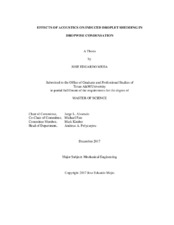| dc.description.abstract | Research studies over the years have confirmed that dropwise condensation is more effective than film-wise condensation since it promotes higher rates of heat transfer. However, droplet shedding in dropwise condensation still is one of the limiting steps in the overall condensation phenomena, even when using engineered surfaces. Therefore, acoustic stimuli should be considered to promote adequate droplet shedding during condensation. To that end, an acoustic system has been developed to induce droplet shedding via substrate-droplet resonance.
To understand the relationship between droplet sliding angle and body forces such as gravity and acoustic streaming, a mathematical model has been postulated capable of predicting the critical sliding angle of droplets. Recently, a mathematical physics-based model has been developed, which can predict droplet-sliding angles while using a variety of surfaces including those with hydrophobic and hydrophilic wetting characteristics. The model has been validated experimentally with and without imposing acoustic stimuli under the influence of gravity. Initially, the relationship between the sliding angle and droplet volume were investigated experimentally to obtain the contact angle hysteresis for smooth surfaces. Then, different natural frequencies of droplets were also examined to determine the best resonance mode of vibration that leads to lower-sliding angles. Experimental data show that the model can be used effectively to relate imposed resonance frequency to critical sliding angle of droplets.
Experimental results to date also show that surfaces with hydrophobic properties, depict lower condensation rates than hydrophilic surfaces. Moreover, hydrophobic surfaces depict droplets with less contact area and greater surface area on the vapor side, which lead to greater thermal resistance and lower condensation rates. While imposing vibrations to a condensation system, a surface with super-hydrophobic properties shows an enhancement in heat flux of 45%. Furthermore, heat transfer enhancement in both hydrophilic and hydrophobic surfaces can be achieved when the difference between surface temperature and ambient temperature (T) is in the range of 10 to 12.5 °C. In summary, vibrations help shed smaller droplets faster, which allow for faster rate of dropwise condensation. Furthermore, vibrations help mitigate the effects of surface tension on condensation. | en |


